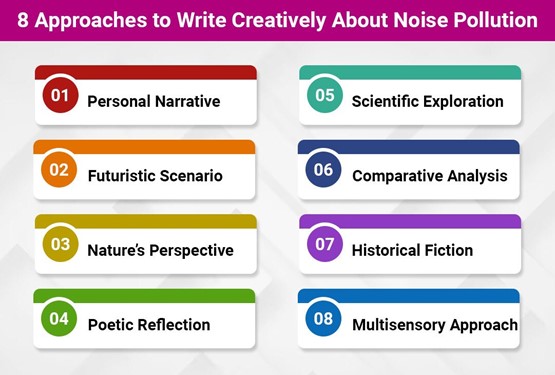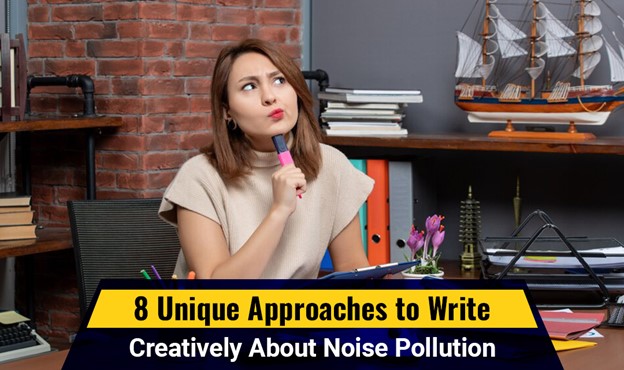Creative writing on noise pollution highlights a problem that is often overlooked but has a huge impact on the environment. Millions of people around the world are affected by noise, which causes chronic health problems such as heart disease and hearing loss. Writing can also engage them mentally, helping them to understand the importance of reducing the noise around them.
Through creative writing, you can explore noise pollution from a variety of sources, including records, local history, and future possibilities. Therefore, this article gives you innovative approaches to dealing with noise pollution and can encourage readers to consider how it affects their lives and take steps to reduce it.
But, before delving into the strategies, you must know what noise pollution is.
What is Noise Pollution?
Environmental noise that disrupts the natural balance, posing a threat to the well-being of animals, humans, and the ecosystem is known as noise pollution. Noise, often invisible, can cause serious health issues like stress, sleep disturbances, hearing loss, and reduced living standards compared to air or water contamination.
Moreover, people who work in high levels of noise environments are often subject to other chronic conditions due to exposure to excessive noise, for example, cardiovascular disease.
How to Write Creatively on Noise Pollution? 8 Unique Approaches
Creative writing on noise pollution can enhance cognitive and learning experiences. Noise pollution is detrimental to the environment, human health and well-being and many of these effects can be highlighted. Readers can gain a greater understanding of the nuances, empathy and insight.
However, if you struggle to articulate ideas creatively, enlisting the help of online essay writing agencies can be a great way to express your ideas clearly. This article also describes the following different approaches to writing an essay on noise pollution.

1. Personal Narrative
The use of personal story-style creative writing on noise pollution based on personal experiences effectively connects readers with the topic and deeply impacts them. For example, you could explain how the proximity of a busy highway made it difficult to sleep, caused stress and even caused health issues.
To grasp the readers with your personal story, you may comprehensively describe never-ending traffic jams, painful car brakes, and the damage it does to your physical and mental well-being.
Key Elements of the Personal Narrative Approach
- Personal narratives engage the readers thus ensuring the topic is less daunting.
- Include instances or memories of actual noise pollution and how it interferes with different aspects of life.
- Pay special attention to how specifically noise pollution has negatively influenced health in particular and who exactly was affected.
- Enhance the story further by adding background sounds, pictures, and the moods of people.
- Finally, write about what you have found out or how your perception of noise pollution has changed.
2. Futuristic Scenario
It is interesting to explore noise pollution based on a futuristic view where people visualise a society where civilisation is drowned by noise. It is this technique that enables one to construct a future which is obscene and filled with noise. It could mean picturing such cities where constant noise has made it nearly impossible to carry out a normal discussion or requiring people to wear helmets while operating due to excessive sound.
Instead of bringing in the present, the writer brings in a situation from the future so that readers understand the consequences of ignoring noise pollution today. Creative writing on noise pollution effectively portrays the negative impacts of a situation while also involving characters who counteract it, either technologically or legislatively. The strategy engages readers with an imagined future disaster and highlights the consequences of controlling noise pollution.
3. Nature’s Perspective
Creative writing on noise pollution should consider nature’s perspective, seeking opinions from animals or plants rather than solely relying on human explorations. This gives those creatures who have mostly ignored a voice and pictures of how these high levels of noise affect the ecology. For instance, writing can be linked to a dolphin making contact in the water but no one seems to be listening due to sonars and other ships.
Consequently, noise pollution affects many activities as it creates disorientation, fear, and stress among people. Students argue that the excess noise can also affect the interdependence of plants and animals.
It also calls for an analysis of how students perceive the sound environment and the effects of noise on the interactions between people and their natural environment. Students investigate the impact of this form of pollution on humans, their daily activities and nature. If you’re having trouble putting these complex concepts into words, the best option is to buy essays online from legitimate experts.
4. Poetic Reflection
The poetic reflection method effectively generates creative ideas for writing on noise pollution issues through various methods. The way this method works is through the use of poetic images and poetic techniques to evaluate noise pollution as an environmental and social concern. This technique enables writers to create compelling and thought-provoking writings that encourage action or raise concerns on specific issues.
The Advantages of the Poetic Reflection Approach
Some of the benefits include:
- Framing the problem in a poetic form and thus drawing the attention of the stakeholders, editors, and others to the problem.
- Some readers may even be more sympathetic, feeling more actively involved in the action as the noise is thus personified.
- Symbolism can help the readers appreciate the intricate details of noise pollution and its impacts on the environment.
- It promotes community and shared responsibility by encouraging readers to recognise the negative impact of noise pollution and actively seek solutions.
5. Scientific Exploration
The scientific exploration of noise pollution is very interesting as it combines knowledge and facts into essays. As such, noise exposure is recognised as an important factor behind stress-related health problems such as hearing dysfunction and hypertension.
Moreover, this approach emphasises excessive noise pollution’s adverse effect on humans and the environment by creatively presenting unpleasant scientific data. Students should provide readers with a balanced approach to creating realism and proposing solutions by comparing current practices with desired outcomes.
This strategy also includes other alternatives such as noise control measures or the introduction of soundproofing regulations. It may be beneficial to the readers to appreciate the problem and come up with strategies on how to tackle it. Scientific facts on noise pollution are attached to stories to enhance the clarity and effectiveness of the existing strategies.
6. Comparative Analysis
The comparative analysis methodology provides a creative method for analysing the presence of noise in various locations, times, and cultures. Students can demonstrate the significant difference in sound environments and health aspects between urban noise and rural quiet while creative writing on noise pollution.
The study compares noise pollution control laws in expanding and busy cities. Students focus on loudness compliance to understand how different cultures handle noise pollution. One can make this comparison and demonstrate creatively how the two scenarios differ in terms of noise management and what can be learned from each.
By selecting appropriate places, and times in history or societies for comparison a comparative study also deepens the subjects of the research. Furthermore, students undergo a thorough investigation into the causes and effects of excessive noise pollution while creative writing on noise pollution. It also helps in the evaluation of the management of noise in different environments raising the possibility of the solutions being applied at a global level.
7. Historical Fiction
Historical fiction presents a unique perspective on noise pollution, blending genuine history with fiction to explore its impact on societies. The spatial setting allows the reader to explore the effects of industrialisation, urbanisation and technical advancement on the soundscapes.
In a fictional novel, sound evolution from calm nature to noisy machines in the late 19th century could be depicted, evoking socio-economic changes from the Industrial Revolution. Creative writing on noise pollution emphasises the historical responsibility of noise pollution prevention. This may encourage a change in perceptions of noise, retaining interest in sound and its impact.
8. Multisensory Approach
To effectively tackle noise pollution, a multi-sensory approach is crucial for engaging readers at various levels, resulting in more engaging and impactful reading. In addition to the auditory sense, you may also include certain sights, smells, touches and tastes in your writing that connote the idea of noise pollution. For instance, a city’s traffic noise can be visualised through impatient drivers’ car horns, repetitive construction hammer bonks, and mixed voices, creating a hushing sound.
Moreover, expert essay writers in the UK can make the visual image of the reader more dynamic by adding some auditory metaphors that would help readers imagine hearing chaos in a mess. Nevertheless, your writing enhances and transforms into a powerful tool for readers to understand and appreciate the total problem of noise pollution in our daily lives.
Conclusion
Creative writing on noise pollution presents a unique opportunity to capture the reader’s interest in a problem that is often overlooked until it has mounted into a significant issue. It is possible for a writer through different unique methods to emphasise the great effects that noise has on the environment as well as the person. These approaches help many to reflect upon their memories to accept change, and at the same time raise awareness of noise pollution problems.
Moreover, students can drive societal and leadership changes, foster teamwork, and promote harmonious environments when they write noise pollution essays. Creatively addressing noise pollution can encourage students to engage readers in everyday life.

